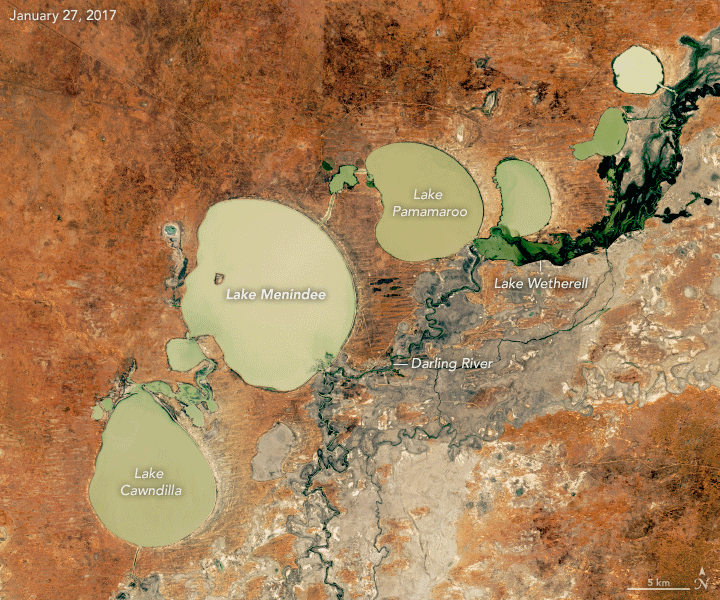


In December 2016, the Menindee Lakes of New South Wales were nearly brimming with water. More than two years later, these Australian lakes are almost desiccated.
These satellite images show the dwindling water levels of the Menindee Lakes, a chain of freshwater lakes located 110 kilometers (70 miles) southeast of Broken Hill. The shallow natural depressions were developed into water storage by the Australian government to manage river flows. The images were acquired by the Operational Land Imager on Landsat 8 on January 27, 2017, February 15, 2018, and February 2, 2019. (Click here to see an animation focused on Lake Menindee.)
Water levels often fluctuate as the basins collect precipitation or flood water. Evaporation accounts for about 400 gigalitres of water loss from the lakes every year. Other times the water is released into the nearby Darling River by the New South Wales government. During drought, when less water is coming into the lakes, the basins tend to be drier.
Lake Menindee is the largest of the lakes. But river managers have been keeping as much water as possible upstream in Lake Wetherell and Lake Panamaroo, which supply water to Broken Hill and local communities.
Recent years have brought exceptional drought to the area. New South Wales has faced extremely hot temperatures and low precipitation, causing one of its worst droughts on record.
The Lower-Darling River has been experiencing “extreme low inflows” of water from the Menindee Lakes since August 2018. As of February 18, 2019, the Lower-Darling’s storage level was 1 percent. Water has stopped flowing in parts of the river.
Public concerns drastically increased when millions of fish were found floating belly up along the Darling River on three separate occasions in January 2019. The massive fish kills stemmed from a series of events. As water levels fell, the river stopped flowing, and temperatures were high—creating ideal conditions for blue-green algae to bloom. When a cold front swept through the area and killed the algae, the population of bacteria that feeds on the algae then blossomed. The bacteria consumed most of the available oxygen in the water, causing the fish to suffocate. Some sources say the massive fish kills were partly due to how the Menindee Lakes are managed, while others blame global warming and drought.
NASA Earth Observatory image by Lauren Dauphin, using Landsat data from the U.S. Geological Survey. Story by Kasha Patel.